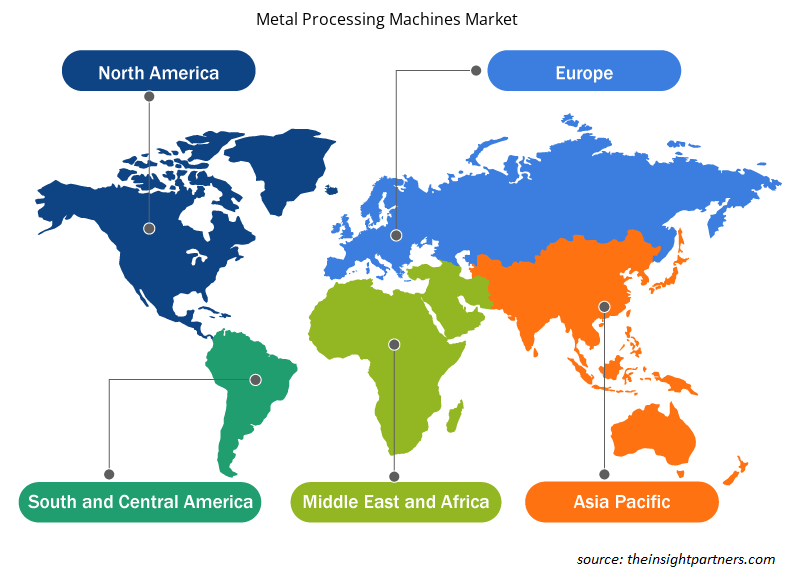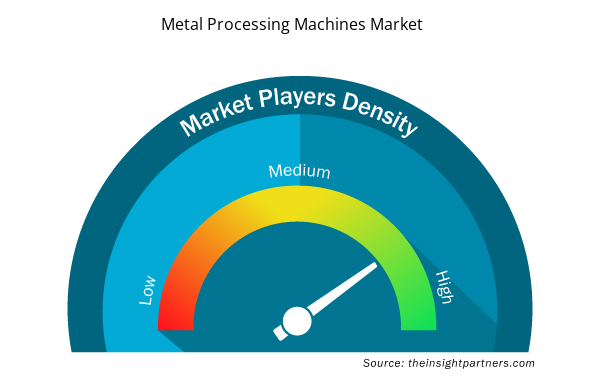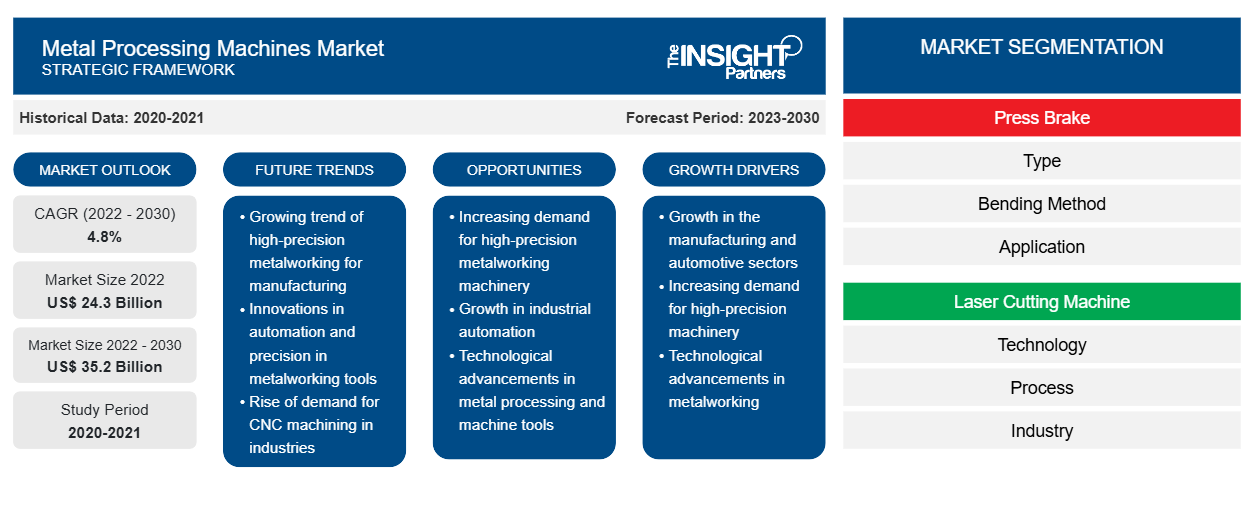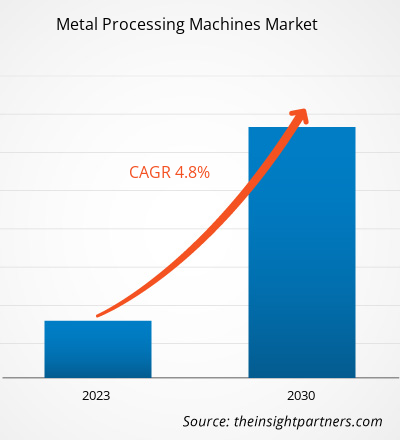[調査レポート] 金属加工機械市場は、2022年の243億米ドルから2030年には352億米ドルに達すると予測されています。2023年から2030年の間に4.8%のCAGRを記録することが期待されています。
アナリストの視点
防衛・航空宇宙部門への投資と、可処分所得の増加に伴う家電製品の需要増加が、市場の成長に寄与すると予想されます。 2022年、タミル・ナドゥ州政府は航空宇宙・防衛産業政策を発表しました。 この政策は、今後10年間で約105億米ドルの多額の投資を誘致し、約10万人の雇用機会を生み出すことを目指しています。 最新技術と製造プロセスの進歩に対する需要が、市場をさらに推進すると予想されます。 板金切断は、航空宇宙、自動車、海洋、建設、電子産業で不可欠です。 市場では、特に組み込みシステムにおいて、デジタル技術の継続的な進歩が見られます。 さらに、積層造形、スマートロボット、コンピューター化された監視および制御システムの革新に焦点が当てられています。 これらの傾向は、金属加工機械の効率と精度を高めることで、市場の成長を促進すると予想されます。
市場概要
金属加工機械は、幅広い鉄および非鉄金属に効率的で正確な切断ソリューションを提供するため、さまざまな業界で不可欠です。金属切断機械は、目的の形状の完成品を生産するために広く利用されており、表面の質感、寸法精度、複雑な形状、必要なサイズなど、多くの利点があります。金属切断機械市場は、高度な機械化切断ソリューションの需要の増加により、予測期間中に大幅に成長すると予想されます。北米では、防衛、航空宇宙、自動車産業からの堅調な需要に牽引され、米国が金属加工機械市場を支配しています。技術革新と軍事費の急増が、この地域の市場を牽引すると予想されます。防衛および航空宇宙部門の主要企業は、航空機の重量を軽減する複雑な部品の設計と製造における製造技術を改善しており、これがレーザー金属切断機械の需要を促進しています。
要件に合わせてレポートをカスタマイズする
このレポートの一部、国レベルの分析、Excelデータパックなど、あらゆるレポートを無料でカスタマイズできます。また、スタートアップや大学向けのお得なオファーや割引もご利用いただけます。
- このレポートの主要な市場動向を入手してください。この無料サンプルには、市場動向から見積もりや予測に至るまでのデータ分析が含まれます。
市場の牽引役
軍事力増強のための政府支出増加が金属加工機械市場の成長を促進
軍事組織は、能力強化のため、防衛装備、兵器システム、車両に多額の投資を行っています。金属加工機械は、装甲板、弾薬、防衛作戦に必要なその他の重要なシステムの製造に不可欠です。国防軍の近代化、国家安全保障の強化、進化する脅威への対応の必要性から、政府は毎年軍事費を増額せざるを得ません。2023年、バイデン・ハリス政権は、2024会計年度予算で国防総省(DoD)に8,420億ドルを割り当てるよう要請しました。これは、2023会計年度より260億ドルの増加です。このような軍事強化のための巨額の財政支援は、防衛関連部品メーカーにさらなる投資を促し、今後数年間で金属加工機械の需要を喚起するでしょう。ウクライナとロシアの戦争は防衛活動への投資を促進しました。その結果、世界中の多くの国が防衛予算を増額しました。最先端の兵器や防衛システムを製造するには、金属部品の精密な製造、成形、組み立てが製品の最適な性能と耐久性に不可欠であるため、高度な金属加工機械が必要です。
車両装甲の改善と軍事インフラのアップグレードの必要性により、金属加工機械の需要がさらに高まっています。これらの機械は、特殊な材料の加工や、装甲車両、戦車、軍用機の重要な部品の製造に使用されます。2022年、米国に拠点を置くレイセオンテクノロジーズのコリンズエアロスペースは、インドに2億ドルを投資し、ベンガルールに新しいグローバルエンジニアリングテクノロジーセンター(GETC)とコリンズインドオペレーションセンターを開設しました。この動きにより、コリンズエアロスペースは、デジタルテクノロジーとエンジニアリング機能の獲得により、製造業務を拡大する予定です。企業によるこのような取り組みは、国内の金属加工機械メーカーが顧客を拡大するのに役立つでしょう。さらに、防衛費の急増は既存の防衛大国に限定されず、多くの新興経済国が防衛予算の増加を示しています。金属加工機械メーカーは、防衛産業の独自の要件を理解し、国内外の品質基準と規制に準拠したソリューションを開発する必要があります。これは、防衛組織との緊密な連携と、継続的な革新努力によるカスタマイズされたソリューションを提供する能力を通じて実現できます。したがって、世界規模での防衛費の急増は、金属加工機械市場に大きな後押しをもたらします。
セグメント分析
タイプに基づいて、世界の金属加工機械市場は、手動、油圧、電子に分類されます。予測期間中、油圧プレスブレーキが市場を支配します。油圧プレスブレーキは、その強化されたパワーと汎用性により、金属加工業界で大きな人気を博しています。油圧システムは、金属を曲げるために必要な力を生成するために使用されます。油圧プレスブレーキは優れた制御を提供し、オペレーターは圧力や速度などのパラメーターを正確に調整できます。さまざまな材料や厚さに対応できるため、木材、金属、自動車などのさまざまな用途に適しています。また、油圧プレスブレーキは低コストのため、機械式プレスブレーキに取って代わりました。また、可変速度制御を備えているため、油圧プレスブレーキが広く受け入れられました。油圧プレスブレーキの需要は、効率、使いやすさ、複雑な曲げ作業を処理できるため、かなりありました。コンピューター数値制御(CNC)技術の採用により、油圧プレスブレーキにさらなる革命が起こり、自動化された操作が可能になり、精度が向上しました。油圧プレスブレーキの最終ユーザーは、金属加工工場、自動車メーカー、航空宇宙産業、および大量かつ精密な曲げ作業を必要とする分野です。
地域分析
アジア太平洋地域の金属加工機械市場は、2022年に102億米ドルと評価され、2030年までに157億米ドルに達すると予測されており、2023年から2030年にかけて5.7%のCAGRで成長すると予想されています。 アジア太平洋地域の金属加工機械市場は、韓国、インド、中国、日本、オーストラリア、その他のアジア太平洋地域に分割されています。 この地域は、インド、中国、インドネシア、フィリピンなど、さまざまな成長経済で構成されています。 これらの国々では、先進技術の採用が徐々に増加しています。 さらに、低い人件費、低い税金と関税、強力なビジネスエコシステムが利用可能であることから、製造業の世界的プレーヤーがこの地域で製造施設を拡張しています。 2021年10月、世界最大のアルミニウムリサイクル会社の1つであるNovelisは、自動車業界で使用されるアルミニウム製品のリサイクルおよび生産施設の拡張に3億7,500万米ドルを投資すると発表しました。 2022年11月、ケナメタル社はインドのバンガロールに新しい金属切削インサート製造施設を開設すると発表しました。この戦略的開発により、同社はAPAC市場からの高まる需要を満たすために能力と容量を強化することを目指しています。したがって、成長を続けるAPACの製造業は、今後数年間で金属加工機械市場に有利な機会を提供すると予想されます。中国は生産量で世界最大の製造国であり、世界の製造業の中心地となっています。世界鉄鋼協会AISBLによると、中国は2021年に10億3,280万トンで世界最大の鉄鋼生産国でした。中国には、中国宝武グループ、沙鋼グループ、江龍グループ、首鋼グループなど、金属生産業界のいくつかの主要な市場プレーヤーが存在し、金属生産業界の成長をサポートしています。したがって、さまざまな市場プレーヤーは、世界最大の金属製造市場の1つに近い金属加工施設を拡張することで、輸送コストを削減し、輸入手続きを簡素化することを目指しています。中国における金属製造業の成長は、金属加工機械の需要を後押ししています。さらに、中国の都市化の進展により、同国では建築・建設市場が急速に成長しています。アメリカ建築家協会(AIA)が発表したレポートによると、中国は2025年までにニューヨークの10都市に相当する都市を建設する必要があるとのことです。この目標を達成するために、中国政府は中国の建築・建設業界向けにいくつかの都市再生政策を実施しています。曲げ加工機は、足場安全フック、天井フック、コンクリートフレームワークなど、建設業界のさまざまな用途に使用されています。したがって、成長する中国の建築・建設業界は、金属加工機械市場に有利な成長機会をもたらすと予想されています。
キープレーヤー分析
金属加工機械市場分析には、Durmazlar Machinery Inc、Ermaksan Makina Sanayi Ve Ticaret AŞ、Dener Makina、LVD Company NV、Baykal Makina、Salvagnini Italia Spa、Amada (India) Pvt LTD、Prima Industrie SPA、Bystronic Group、Trumpf などの企業が含まれています。金属加工機械の企業の中で、Prima Industrie SPA と Durmazlar Machinery Inc は、多様な製品ポートフォリオを提供していることから、トップ 2 の企業となっています。
金属加工機械市場の地域別分析
予測期間を通じて金属加工機械市場に影響を与える地域的な傾向と要因は、Insight Partners のアナリストによって徹底的に説明されています。このセクションでは、北米、ヨーロッパ、アジア太平洋、中東、アフリカ、南米、中米にわたる金属加工機械市場のセグメントと地理についても説明します。

- 金属加工機械市場の地域別データを入手
金属加工機械市場レポートの範囲
| レポート属性 | 詳細 |
|---|---|
| 2022年の市場規模 | 243億米ドル |
| 2030年までの市場規模 | 352億米ドル |
| 世界のCAGR(2022年 - 2030年) | 4.8% |
| 履歴データ | 2020-2021 |
| 予測期間 | 2023-2030 |
| 対象セグメント | プレスブレーキ
|
| 対象地域と国 | 北米
|
| 市場リーダーと主要企業プロフィール |
|
金属加工機械市場のプレーヤー密度:ビジネスダイナミクスへの影響を理解する
金属加工機械市場は、消費者の嗜好の変化、技術の進歩、製品の利点に対する認識の高まりなどの要因により、エンドユーザーの需要が高まり、急速に成長しています。需要が高まるにつれて、企業は提供を拡大し、消費者のニーズを満たすために革新し、新たなトレンドを活用し、市場の成長をさらに促進しています。
市場プレーヤー密度とは、特定の市場または業界内で活動している企業または会社の分布を指します。これは、特定の市場スペースに、その規模または総市場価値と比較して、どれだけの競合相手 (市場プレーヤー) が存在するかを示します。
金属加工機械市場で事業を展開している主要企業は次のとおりです。
- トルンプ
- バイストロニックグループ
- プリマ インダストリー スパ
- 株式会社アマダ
- サルヴァニーニ イタリア スパ
免責事項:上記の企業は、特定の順序でランク付けされていません。

- 金属加工機械市場のトップキープレーヤーの概要を入手
最近の動向
金属加工機械市場の企業では、合併や買収などの無機的および有機的な戦略が広く採用されています。最近の主要な市場動向をいくつか以下に示します。
- 2022 年、LVD は、総所有コストを抑えながらハイテク機能とパフォーマンスを提供するように設計された、コスト効率の高い新しいファイバー レーザー切断機 Puma を発表しました。3、6、12 kW のレーザーを 3050 x 1525 mm、4065 x 2035 mm、6160 x 2035 の形式で提供し、自動化にも対応した Puma は、多様な切断アプリケーションを管理する機能を提供します。
- 2021年、Ermaksanは、TOWERMAK全自動ローディングおよびアンローディングシステムを備えた10kW FIBERMAKシリーズレーザー切断機をセルビアの顧客サイトに設置しました。
- 2022年、チューブ見本市で、ハイテク企業TRUMPFはレーザーチューブ切断機用の新しい自動ローディングソリューションを発表する予定です。保管システムメーカーSTOPAと共同で開発されたTRUMPFの新しいソリューションは、保管システムからチューブ切断機にチューブを自動的に移送します。
- 2021年、ハイテク企業TRUMPFは、生産性、プロセス安定性、コスト効率が向上した新世代のTruLaserシリーズ1000を発表しました。このマシンタイプでは、初めてHighspeed Eco機能が採用されています。
- 2023年、LVD Company NVは、ハウトハーレン=ヘルヒテレンにあるKUKA Automatisering + Robotics NVのソリューション事業部門を買収し、新しい会社であるLVD Robotic Solutionsを設立しました。これにより、ロボット自動化におけるLVDの専門知識と市場範囲が大幅に向上します。
- 過去2年間の分析、基準年、CAGRによる予測(7年間)
- PEST分析とSWOT分析
- 市場規模価値/数量 - 世界、地域、国
- 業界と競争環境
- Excel データセット


- Semiconductor Metrology and Inspection Market
- Point of Care Diagnostics Market
- Wheat Protein Market
- Emergency Department Information System (EDIS) Market
- Electronic Data Interchange Market
- Small Internal Combustion Engine Market
- Influenza Vaccines Market
- 3D Mapping and Modelling Market
- Micro-Surgical Robot Market
- Frozen Potato Market

Report Coverage
Revenue forecast, Company Analysis, Industry landscape, Growth factors, and Trends

Segment Covered
This text is related
to segments covered.

Regional Scope
North America, Europe, Asia Pacific, Middle East & Africa, South & Central America

Country Scope
This text is related
to country scope.
よくある質問
The global metal processing machines market was estimated to be USD 24.3 billion in 2022 and is expected to grow at a CAGR of 4.8 %, during the forecast period 2023 - 2030.
The key players, holding majority shares, in metal processing machines market includes TRUMPF SE + Co KG, Amada (India) Pvt Ltd, Prima Industrie SpA, LVD Company NV and Bystronic AG.
The metal processing machines market is expected to reach US$ 35.2 billion by 2030.
The incremental growth, expected to be recorded for the metal processing machines market during the forecast period, is US$ 9.92 billion.
The development of user-friendly interfaces is an important trend that will shape the future of the metal processing machine market.
APAC is anticipated to grow with the highest CAGR over the forecast period with a CAGR of 5.7%.
The growing demand of machines from automotive & aerospace industries . Further, increasing government spending on military reinforcement for defence equipment, weapons systems, and vehicles to strengthen their capabilities are the major factors that propel the metal processing machines market growth.
Trends and growth analysis reports related to Manufacturing and Construction : READ MORE..
The List of Companies - Metal Processing Machine Market
- TRUMPF
- Bystronic Group
- PRIMA INDUSTRIE S.P.A.
- AMADA CO.,LTD.
- Salvagnini Italia SPA
- Baykal Makina
- LVD Company NV
- Dener Makina
- Ermaksan
- Durmazlar Machinery Inc.
The Insight Partners performs research in 4 major stages: Data Collection & Secondary Research, Primary Research, Data Analysis and Data Triangulation & Final Review.
- Data Collection and Secondary Research:
As a market research and consulting firm operating from a decade, we have published and advised several client across the globe. First step for any study will start with an assessment of currently available data and insights from existing reports. Further, historical and current market information is collected from Investor Presentations, Annual Reports, SEC Filings, etc., and other information related to company’s performance and market positioning are gathered from Paid Databases (Factiva, Hoovers, and Reuters) and various other publications available in public domain.
Several associations trade associates, technical forums, institutes, societies and organization are accessed to gain technical as well as market related insights through their publications such as research papers, blogs and press releases related to the studies are referred to get cues about the market. Further, white papers, journals, magazines, and other news articles published in last 3 years are scrutinized and analyzed to understand the current market trends.
- Primary Research:
The primarily interview analysis comprise of data obtained from industry participants interview and answers to survey questions gathered by in-house primary team.
For primary research, interviews are conducted with industry experts/CEOs/Marketing Managers/VPs/Subject Matter Experts from both demand and supply side to get a 360-degree view of the market. The primary team conducts several interviews based on the complexity of the markets to understand the various market trends and dynamics which makes research more credible and precise.
A typical research interview fulfils the following functions:
- Provides first-hand information on the market size, market trends, growth trends, competitive landscape, and outlook
- Validates and strengthens in-house secondary research findings
- Develops the analysis team’s expertise and market understanding
Primary research involves email interactions and telephone interviews for each market, category, segment, and sub-segment across geographies. The participants who typically take part in such a process include, but are not limited to:
- Industry participants: VPs, business development managers, market intelligence managers and national sales managers
- Outside experts: Valuation experts, research analysts and key opinion leaders specializing in the electronics and semiconductor industry.
Below is the breakup of our primary respondents by company, designation, and region:

Once we receive the confirmation from primary research sources or primary respondents, we finalize the base year market estimation and forecast the data as per the macroeconomic and microeconomic factors assessed during data collection.
- Data Analysis:
Once data is validated through both secondary as well as primary respondents, we finalize the market estimations by hypothesis formulation and factor analysis at regional and country level.
- Macro-Economic Factor Analysis:
We analyse macroeconomic indicators such the gross domestic product (GDP), increase in the demand for goods and services across industries, technological advancement, regional economic growth, governmental policies, the influence of COVID-19, PEST analysis, and other aspects. This analysis aids in setting benchmarks for various nations/regions and approximating market splits. Additionally, the general trend of the aforementioned components aid in determining the market's development possibilities.
- Country Level Data:
Various factors that are especially aligned to the country are taken into account to determine the market size for a certain area and country, including the presence of vendors, such as headquarters and offices, the country's GDP, demand patterns, and industry growth. To comprehend the market dynamics for the nation, a number of growth variables, inhibitors, application areas, and current market trends are researched. The aforementioned elements aid in determining the country's overall market's growth potential.
- Company Profile:
The “Table of Contents” is formulated by listing and analyzing more than 25 - 30 companies operating in the market ecosystem across geographies. However, we profile only 10 companies as a standard practice in our syndicate reports. These 10 companies comprise leading, emerging, and regional players. Nonetheless, our analysis is not restricted to the 10 listed companies, we also analyze other companies present in the market to develop a holistic view and understand the prevailing trends. The “Company Profiles” section in the report covers key facts, business description, products & services, financial information, SWOT analysis, and key developments. The financial information presented is extracted from the annual reports and official documents of the publicly listed companies. Upon collecting the information for the sections of respective companies, we verify them via various primary sources and then compile the data in respective company profiles. The company level information helps us in deriving the base number as well as in forecasting the market size.
- Developing Base Number:
Aggregation of sales statistics (2020-2022) and macro-economic factor, and other secondary and primary research insights are utilized to arrive at base number and related market shares for 2022. The data gaps are identified in this step and relevant market data is analyzed, collected from paid primary interviews or databases. On finalizing the base year market size, forecasts are developed on the basis of macro-economic, industry and market growth factors and company level analysis.
- Data Triangulation and Final Review:
The market findings and base year market size calculations are validated from supply as well as demand side. Demand side validations are based on macro-economic factor analysis and benchmarks for respective regions and countries. In case of supply side validations, revenues of major companies are estimated (in case not available) based on industry benchmark, approximate number of employees, product portfolio, and primary interviews revenues are gathered. Further revenue from target product/service segment is assessed to avoid overshooting of market statistics. In case of heavy deviations between supply and demand side values, all thes steps are repeated to achieve synchronization.
We follow an iterative model, wherein we share our research findings with Subject Matter Experts (SME’s) and Key Opinion Leaders (KOLs) until consensus view of the market is not formulated – this model negates any drastic deviation in the opinions of experts. Only validated and universally acceptable research findings are quoted in our reports.
We have important check points that we use to validate our research findings – which we call – data triangulation, where we validate the information, we generate from secondary sources with primary interviews and then we re-validate with our internal data bases and Subject matter experts. This comprehensive model enables us to deliver high quality, reliable data in shortest possible time.


 このレポートの無料サンプルを入手する
このレポートの無料サンプルを入手する